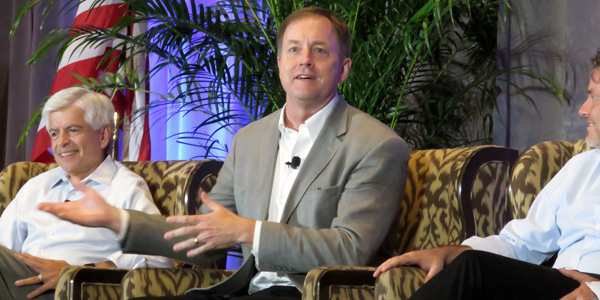By Rich Heidorn Jr.
SCOTTSDALE, Ariz. — It used to take SUEZ in North America four years to apprentice an operator at its Boise, Idaho, water utility, with its 90 “pressure planes” (service territories), 80 tanks and 60-plus source wells.
But after developing an algorithm based on 10 years of supervisory control and data acquisition throughout its network, SUEZ created a system that sets the optimal setting for every pump and integrates data from its power utility to determine the best time to run them.
The result: a 10% reduction in the water company’s energy demand and a $350,000 rebate from the power company.
But that wasn’t the biggest achievement, David Stanton, SUEZ’s president of utility operations and federal services, told the National Association of Regulatory Utility Commissioners’ Summer Policy Summit last week. Stanton was invited to speak at Monday’s general session by NARUC President Jack Betkoski, who has made the “water-energy nexus” the centerpiece of his year as head of the state regulators.
“Because we’re capturing knowledge in the system, we now can train operators within six months,” Stanton said. “So we’re actually solving what I think is a much more systemic big problem” — an aging workforce.
Stanton said the new system illustrates his company’s need to “reinvent” its information technology. “Traditionally we talk about technology in the context of physical assets. But more and more I’m thinking that the data … that’s coming is going to change the physical technology asset that we want to deploy dramatically. So we really have to solve for data innovation first.”
That means not using enterprise resource planning (ERP) systems like SAP and Oracle for managing big data. “You need ERPs for financials and maybe billing, but you want an innovative environment … that is safe and secure and isolated from your ERP. The future of IT has much more to do with the sources of data and operations than it does big back-office ERPs.”
‘Benchmark Like Crazy’
Four years into what Stanton called the company’s “smart utility” program, he shared his lessons learned.
“We benchmark like crazy. Everything we do that we like, we go find somebody that’s already done it and does it really well. And we go worldwide with the benchmarking.”
SUEZ implemented innovations “at scale” but at one regional utility at a time, Stanton said. “And then once it worked, we hopscotched that out to other regions.
“We never went out and did everything at once, and as a result, we were running 12 or 14 projects around our utility footprint nationwide. … We never bet the ranch on one idea. If something didn’t work, we could throw it out.”
But getting other regions to buy in was a problem, Stanton said. “A lot of utilities run their regions with a strong president or general manager for each region. Getting them to work together … is like a ‘Game of Thrones’ type of activity.
“Once we had enough of these project implementations working, I made 50% of the bonus of each leader dependent on their ability to get what they implemented adopted by the other utilities. So half their bonus all the sudden was based on, ‘If I do it your way for your project, you have to do it my way for my project. We’ve got to work this out.’
“In two weeks, we had everything worked out. We had heard for years that New York couldn’t do it like New Jersey. … So that solved the cultural problem almost overnight.”
‘First Customer’ Syndrome

Also appearing on the panel was Oded Distel, founder and director of Israel NewTech, a program in the country’s Ministry of Industry, Trade and Labor that supports research in the water and renewable energy sectors. Distel described how Israel overcame the reluctance of utilities to become the “first customer” for new technologies.
“We encourage utilities … and tech companies to come together. They form a joint project for the first implementation of a new technology and then the government supports those projects. The money is not huge but … the guy who has to make the decision — the head of the utility, the chief engineer — feels that he’s not alone. He’s part of a national effort. … If something fails, he’s not left there alone to pay the price,” Distel said. “The influence over the utilities was amazing. All of the sudden, they opened up, and they started thinking and having discussions in a totally different manner.”
Dan Arvizu, recently appointed chancellor of New Mexico State University, told regulators about his experience as director of the National Renewable Energy Laboratory between 2005 and 2015.
“Even though our public policy at the federal level — and many times at the state level — aspired to do certain things, the technology was typically ahead of the policy, and the finance was way behind,” he said.
He offered his own advice for innovating: “You need to think big, you need to try small, you need to fail fast and then regroup and then try and scale again.”
And he had a warning for utilities about the new customer choices that will become available from the falling prices of renewables and energy storage. “If utilities are not on the forefront [of the transformation], they could become obsolete,” he said.






